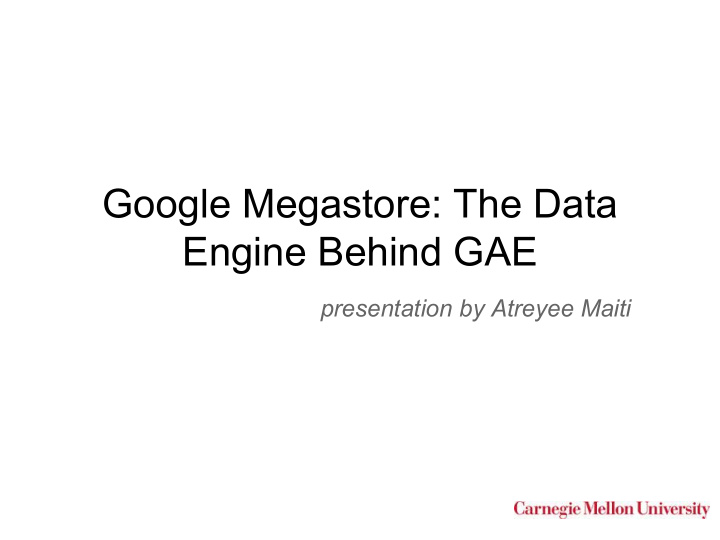



Google Megastore: The Data Engine Behind GAE presentation by Atreyee Maiti
What is it? ● Best of both worlds - NoSQL and relational ● Fully serializable ACID in fine grained data partitions ● Designed for interactive online services which pose challenging requirements
Handles more than three billion write and 20 billion read transactions daily and stores nearly a petabyte of primary data across many global datacenters. Being used for google app engine since 2009 and hundreds of google applications
Brief overview of main concepts ● Replication ● Partitioning ● Entity Groups ● Data model ● Transactions
Replication Needed across wide geographic area Possible Strategies: ● async master/slave ● sync master ● optimistic replication
Paxos to the rescue! ● Inherently fault tolerant ● Write ahead log replicated over peers ● Acknowledges when majority of replicas have changes others catch up when able to
Partitioning and locality source: J. Baker, et al., MegaStore: Providing Scalable, Highly Available Storage For Interactive Services
source: J. Baker, et al., MegaStore: Providing Scalable, Highly Available Storage For Interactive Services
Entity group boundaries email blogs - profiles
● Storing data - uses big table ● For low latency, cache efficiency, and throughput, the data for an entity group are held in contiguous ranges of Bigtable rows. ● Schema language lets applications control the placement of hierarchical data, storing data that is accessed together in nearby rows or denormalized into the same row.
API design philosophy ● Aim is to serve interactive apps - cannot afford expensive joins ● Move complexity to writes because reads are higher ● Joins not needed because of the hierarchical organization in big table
Data model source: J. Baker, et al., MegaStore: Providing Scalable, Highly Available Storage For Interactive Services
Indexes ● Could be on any property ● Local - to search within entity group ● Global - to find across entity groups - without knowing which group they belong to - find all photos tagged by big data ● Storing clause - add additional properties on the entity for faster retrieval ● Repeated indexes - for repeated properties ● Inline indexes - for extracting info from child entities and storing in parent for fast access - can be used to implement many to many links
Mapping to Bigtable Megastore table name + property name = Bigtable column name metadata maintained in same row of Bigtable - atomicity source: J. Baker, et al., MegaStore: Providing Scalable, Highly Available Storage For Interactive Services
Transactions and concurrency control ● Each entity group like a mini db with serializable ACID semantics. A transaction writes its mutations into the entity group's write-ahead log, then the mutations are applied to the data ● Implements multiversion concurrency control (MVCC) ● Provides current, snapshot and inconsistent reads
Transaction lifecycle Read from bigtable and Read Commit gather writes into log entry return to the client, but make best-effort attempt Apply to wait for the nearest replica to apply. Cleanup
Queues A way to batch multiple updates into a single transaction, or to defer work For example, calendar application
Replication in detail ● Reads and writes can be initiated from any replica, and ACID semantics are preserved. ● Replication is done per entity group by synchronously replicating the group's transaction log to a quorum of replicas
Megastore’s usage of paxos source: J. Baker, et al., MegaStore: Providing Scalable, Highly Available Storage For Interactive Services
Algorithms Determine If local Select replica Query highest replica that has local possibly then read applied committed through that log position position If not, read from majority replicas to find maximum and pick a replica Validate Query data Catchup
Comparison Name of System Difference Bigtable, Cassandra, traditional RDBMS systems properties not sacrificed and PNUTS synchronous replication schemes with consistency These systems often reduce the scope of transactions to the granularity of single key access and place hurdle to building applications - lack rich data model Bigtable replication replicates at the level of entire entity group transactions, not individual Bigtable column values.
Limitations ● Fault tolerance is fault masking ● Chain gang throttling ● Achieving good performance for more complex queries requires attention to the physical data layout in Bigtable ● Megastore does not enforce specific policies on block sizes, compression, table splitting, locality group, nor other tuning controls provided by Bigtable.
Conclusion ● As Brewer’s CAP theorem showed, a distributed system can’t provide consistency, availability and partition tolerance to all nodes at the same time. But this paper shows that by making smart choices we can get darn close as far as human users are concerned. ● Megastore is perhaps the 1st large-scale storage system to implement Paxos-based replication across datacenters while satisfying the scalability and performance requirements of scalable web applications in the cloud.
References / Acknowledgements http://googleappengine.blogspot.com/2009/09/migration-to- better-datastore.html http://googleappengine.blogspot.com/2010/06/datastore- performance-growing-pains.html http://storagemojo.com/2011/04/20/googles-megastore/ http://www.informationweek.com/internet/google/google- spills-megastores-secrets/229205494
Resources http://static.googleusercontent. com/external_content/untrusted_dlcp/www.google. com/en/us/events/io/2011/static/presofiles/more_9s_under_ the_covers_of_the_high_replication_datastore.pdf http://www.youtube.com/watch?v=tx5gdoNpcZM
Recommend
More recommend